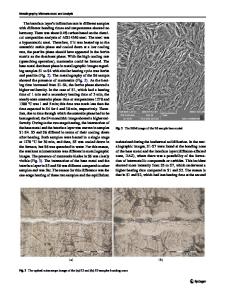Low- Temperature improvement of mechanical properties of aisi 4340 steel through high-temperature thermomechanical treat
- PDF / 2,663,841 Bytes
- 10 Pages / 597 x 774 pts Page_size
- 100 Downloads / 389 Views
I.
INTRODUCTION
IN recent years, the use of ultrahigh-strength low-alloy steels, i.e., AISI 4340 and 300-M, for critical structural applications in aircraft and aerospace vehicles has increased. However, the use of these steels is limited by their poor toughness in low ambient temperatures. Brittle fracture has to be given serious consideration. This therefore requires a modification to toughness at these temperatures. So far, considerable effort has been directed toward improving the mechanical properties of the ultrahigh-strength steels by various heat-treating techniques or compositional modifications,tH2] Many investigations t~-9)have suggested that austenitizing AISI 4340 and similar steels at high temperature (HAT) over 1373 K, instead of the conventional austenitizing temperature of 1143 to 1173 K, dramatically increases the plane-strain fracture toughness (Kzc) for the as-quenched state, while a marked improvement in the K~c with HAT process is often not paralleled with a corresponding increase in Charpy V-notch (CVN) impact energy. Thomas a n d c o - w o r k e r s [l~ have developed Fe-Cr-C-base ultrahigh-strength steels. They have shown that Fe-4Cr-0.35C steel, when compared with commercially quenched and tempered steels, has a better combination of strength and Ktc at 1900 to 2100 MPa strength levels. In addition, alloying of Ni with Fe-4Cr-C-base steel resulted in a Ktc value of 140 MPa. m 1/2 at the 1600 MPa strength level. Unfortunately, this effort has not resulted in any great improvements in the low-temperature meYOSHIYUKI TOM1TA, Associate Professor, is with the Department of Metallurgical Engineering, College of Engineering, University of Osaka Prefecture, 4-804 Mozu-Umemachi, Sakai, Osaka 591, Japan. Manuscript submitted March 2, 1990. METALLURGICAL TRANSACTIONS A
chanical properties. In such a situation, modified heat treatments t13-t61 have been suggested by the present author and Okabayashi, whereby the low-temperature mechanical properties of commercial 4140 or 4340 ultrahigh-strength low-alloy steel are dramatically improved. The modified heat-treated steels are composed of a mixed structure of martensite and lower bainite, which is produced via short-time isothermal transformation just above its Ms temperature, followed by oil or water quenching and subsequent 473 K tempering. There has recently been an increased demand for ultrahigh-strength low-alloy steels with greatly improved fracture toughness and the Charpy impact energy with an increased strength level at severe low ambient temperatures. One of the potential solutions to the problem is the use of a thermomechanical treatment. Of particular interest is an application of a high-temperature thermomechanical treatment (HTMT) for low-temperature ultrahigh-strength applications, tlT'ls] This process involves deformation at a temperature above Ac3 (stable austenite region) prior to quenching to form martensite. Therefore, this technique has been applied to the lowand medium-alloy steels whose S-curve significantly approaches the left.
Data Loading...











